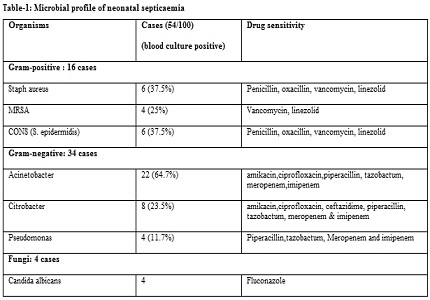Etiological study of neonatal septicaemia
Abstract
Introduction: Neonatal sepsis is a clinical syndrome of bacteremia characterized by systemic signs and symptoms of infection in the first month of life.Our aim was to study the etiological profile of neonatal septicaemia and their sensitivity pattern.
Methodology: The study was conducted over a period of one and half years in the Neonatal Intensive Care Unit (NICU), MMIMSR, Mullana, Ambala, Haryana. A total of 100 cases with positive sepsis screen were identified with standard biochemical tests and these newborns were subjected to blood culture and antimicrobial susceptibility test.
Results: There were 66 male babies and 34 female babies with male: female ratio of 1.9:1. In the study 94% cases were early onset neonatal sepsis and 6% were late onset neonatal sepsis. The blood cultures of 54 babies showed growth, out of these 16 (29.6%) cases were grampositive bacteria, 34(62.9%) were gram negative bacteria and 4(7.4%) showed fungal growth (i.e. candida albicans). Acinetobacter species were most common among gramnegative organisms i.e. 64.7%. Staphylococcus aureus along with coagulase-negative staphylococci (CONS) were common organisms seen among grampositive bacteria. Among gramnegative isolates 62.9% were extended spectrum beta lactamase (ESBL) producers.
Conclusion: Neonatal septicaemia is a life-threatening emergency. The study of etiological profile and their antibiotic sensitivity pattern plays a significant role in decreasing the neonatal mortality rate. The rational use of antibiotics will reduce infection rate ensuring better therapeutic success and reduce the resistance of the organism to available antibiotics.
Downloads
References
2. Sankar MJ, Agarwal R, Deorari AK, Paul VK. Sepsis in the newborn. Indian J Pediatr. 2008 Mar;75(3):261-6. [PubMed]
3. Paul VK and Singh MB. Neonatal sepsis in : Medical Emergencies in Children. Meharban Singh, 3rd edition, Sagar Publications, New Delhi 2000: 117-35.
4. Begum S et al. Bacteriological Profile of Neonatal Sepsis in a Tertiary Hospital in MervatG.Al-Inany. Journal of Bangladesh college of Physicians and Surgeons.2012;30(2):66-70.
5. Naik SA, Met gnd SC, Desai A, Patil CS. Bacteriological Profile of patient with neonatal septicaemia- A hospital based cross sectional study. Indian Journal of Maternal and Child Health 2012, Apr-Jun; 14(2): 1-6.
6. Multu M, Aslan Y, Saygin B, Yilmaz G, Bayramo LU G, Köksal I. Neonatal Sepsis Caused by Gram-negative Bacteria in a Neonatal Intensive Care Unit: A Six Years Analysis .HK J Paediatr (New series) 2011; 16(4):253-257.
7. Bhat RY, Leslie ES Lewis and Vandana KE. Bacterial isolates of early onset neonatal sepsis and their antibiotic susceptibility pattern between 1998 and 2004: An audit from centre in India. Italian Journal of Pediatrics 2011;37:32.
8. Singh M. Care of the newborn. 7th ed. New Delhi: Sagar publications;2010;223-233.
9. CLSI. Performance standards for Antimicrobial Susceptibility testing; twenty first Informational Supplement. CLSI document M100-S21. Wayne,PA: Clinical and Laboratory standards Institute;2011.
10. Jain NK, Jain VM, Maheshwari S. Clinical profile of neonatal sepsis. Kathmandu Univ Med J (KUMJ). 2003 Apr-Jun;1(2):117-20.
11. Jiang JH, Chiu NC, Huang FY, Kao HA, Hsu CH, Hung HY, Chang JH, Peng CC. Neonatal sepsis in the neonatal intensive care unit: characteristics of earlyversuslateonset. J Microbiol Immunol Infect. 2004 Oct;37(5):301-6. [PubMed]
12. Roy I, Jain A, Kumar M, Agarwal SK. Bacteriology of neonatal septicaemia in a tertiary care hospital of northern India. Indian J Med Microbiol. 2002 Jul-Sep;20(3):156-9.
13. Sriram R. Correlation of blood culture results with the sepsis screen in the diagnosis of neonatal septicaemia. Int J Bio Med Res 2011;2(1):360-368.
14. Ahmed AS, chowdhury MA, Hoque M, Darmstadt GL. Clinical and bacteriological profile of neonatal septicaemia in a tertiary level pediatric hospital in Bangladesh. Indian Pediatr.2002;39:1034-9.
15. Kapoor L, Randhawa VS, Deb M. Microbiological profile of neonatal septicemia in a pediatric care hospital in Delhi. J Commun Dis. 2005 Sep;37(3):227-32.
16. Simiyu DE. Neonatal septicaemia in low birth weight infants at Kenyatta National Hospital, Nairobi. East Afr Med J. 2005 Mar;82(3):148-52.
17. Agnihotri N, Kaistha N, Gupta V. Antimicrobial susceptibility of isolates from neonatal septicemia. Jpn J Infect Dis. 2004 Dec;57(6):273-5.
18. Kaistha N, Mehta M, Singla N, Garg R, Chander J. Neonatal Septicaemia isolates and resistance patterns in atertiary hospital of North India. J Infect Dev Ctries.2009;4:55-7.

Copyright (c) 2018 Author (s). Published by Siddharth Health Research and Social Welfare Society

This work is licensed under a Creative Commons Attribution 4.0 International License.


 OAI - Open Archives Initiative
OAI - Open Archives Initiative


